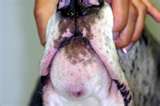Facial Swelling in Dogs
The first sign you will see is inflammation developing in or around their ears
Facial swelling in dogs can be a traumatic experience for both you as well as your dog.
It can also be a very stressful and painful ordeal for your pet, as well as being a condition that can be very difficult in determining the actual cause.
Although in a large majority of the incidents are caused by hives, angioedema, which is the medical term for facial swelling, it can be caused by several other factors.
CAUSES OF FACIAL SWELLING IN DOGS
Urticaria or hives is the most common cause of facial swelling in dogs, and this is a allergic reaction to drugs, chemicals, or something that your dog has eaten that has caused this reaction.
However, what is not well known is that the cause of your dog’s swelling in their face may also be the result of too much sunlight.
However, the most common form of swelling in a dog is the result of an insect sting usually from a bee, wasp, or a hornet.
As a result it causes an immediate allergic reaction or hives.
If the cause of this swelling in your dog is from hives, they will develop small bumps in their skin that surrounds their muzzle and the eyes.
These small bumps will rapidly develop into s swelling that can be so severe in some cases that you will not be able to recognize your own dog.
With hives, your pets face will swell within 20 to 30 minutes after an exposure to an allergen or the allergic substance that your pet has encountered.
In some cases this allergic reaction is caused by a vaccination or a medication that your pet has just been given and if you suspect that this is the cause you will need to contact your veterinarian immediately.
 An injury of some kind may also be the underlying cause
An injury of some kind may also be the underlying causeIn rare cases where sunlight may be the cause of the facial swelling in dogs, it should be treated very seriously, as it could easily be the beginning stages of cancer in your dog.
Just like some humans, a long exposure to the sun can cause cancer and the swelling in their face is the first symptom you will see.
The next set of common causes of facial swelling in dogs is from an infection or a condition known as cellulitis.
This infection is most common in puppy’s and is also referred to as puppy strangles as the swelling can be so severe it actually appears that something or someone is strangling your puppy.
It most commonly attacks a puppy between the ages of 4 weeks to 4 months old.
The first symptoms that you will notice will be an inflammation in or around the ears which is followed by a severe swelling in the mouth, jaws, and the eyes; and then followed a nozzle swelling.
This is an extremely dangerous situation as the swelling cause’s blisters that can become ulcerated and spread rapidly throughout the entire body.
This condition was originally thought to be caused by a bacterial infection, but it was very difficult to actually find the cause.
It is now widely believed to be a hereditary immune deficiency of some kind.
MORE POTENTIAL CAUSES
Other forms of infections that cause facial swelling in dogs are almost always the result of some type of an injury or a wound that has affected your dog.
This type of swelling in your dog’s face will be very warm when you touch them and they are very painful to your pet. The warm feel indicates an infection that is usually followed by a fever.
Acetaminophen toxicity is also one of the major causes of facial swelling in dogs. Acetaminophen is a medication that is commonly used to relieve both fever and pains.
It is found in Tylenol, Percoset, and aspirin free Excedrin.
It can be used in dogs as they are much more tolerate to these medication than cats, but it should never be used without first consulting with your veterinarian.
A 50 pound dog can easily withstand a 500mg dosage, but not if it is administered regularly.
None the less, several owners still commonly use this form of medication and the toxic reaction occurs in three phases that can develop slowly over time or very rapidly, depending on the dosage given to your dog.
Stage one of this toxicity can produce a difficulty in breathing and brown colored gums and occurs in the first 12 hours.
Stage two occurs between 12 and 24 hours after an overdose and it includes severe facial swelling in dogs as well as uncoordinated movements.
Stage three is the liver failure and your dog’s gums, eyes, and skin will start to turn yellow as jaundice sets in.
Hematoma is also a cause of facial swelling and is the result of a large bruise or a blood clot that has occurred as a result of some type of a bleeding disorder in your dog.
This bleeding will usually cause swelling somewhere on their head as well as their face as it spreads.
Summary
Facial swelling in dogs is very difficult to prevent, but in most cases it can be easily treated with antibiotics or corticosteroids if it is from an allergic reaction.
However, it can be somewhat prevented by watching your dog closely as they play in your yard and monitor against insects or by not giving them Acetaminophen unless it is absolutely necessary.
If you do supplement your dog with this pain relief, be very cautious and consult with your veterinarian on the dosage as well as the frequency.
Pet Medications for Facial Swelling in Dogs
Dog Vitamin Store
Radial Nerve Paralysis in Dogs








